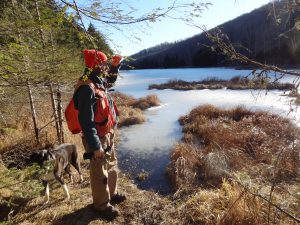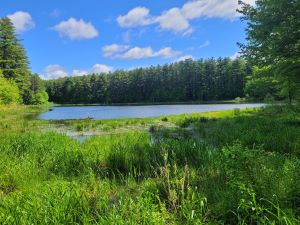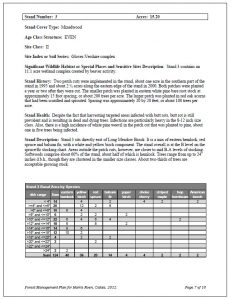Current Use, or Use Value Appraisal (UVA)
Use Value Appraisal is the land premier conservation program in Vermont. Also known as Current Use or UVA, the program promotes conservation values, offers substantial saving on property taxes, protects sensitive areas and supports the working landscape. Vermont foresters can help landowners benefit from this successful land protection program.
What is Current Use?

Current Use is a state program available people in Vermont who own 25 acres or more. It allows landowners to save on property taxes, helps conserve forest and farm land, and supports the working landscape. These multiple goals embodied in Current Use are what make it such a successful land conservation program in Vermont.
The main idea of Current Use is to tax land at the value for which it is being used. Instead of property being taxed at its “highest and best use” price, which is usually its maximum value as a development, it gets taxed at a rate more compatible with income derived from forestry and/or farming. The result is that landowners have less pressure to build due to elevated property taxes.
A second major goal is to allow woodlands to continue to provide ecological, environmental and cultural benefits important to Vermont. This includes wetland protection, wildlife habitat, nutrient cycling erosion control and the like. Also, a well forested landscape provides important recreation opportunities such as hiking, hunting, fishing, skiing, snowmobiling, birding, and general peace and solitude.
Third, the Current Use Program is meant to support the working landscape. By producing locally sourced raw materials for lumber, pulp and wood heat, a well-managed forest provides income to landowners while creating jobs for loggers, mills, land managers and others.
In short, by enrolling in Current Use, landowners agree not to develop their land, and to manage it for forest and/or farm products, and resource protection. In doing so, property taxes are reduced, and in most cases reduced dramatically.
How Does Current Use Work?

Current Use is available for both forest land and farm land. There are many nuances to how Current Use works, but here are the basics.
As a forest land owner, you can choose which parts of the property you want to enter into the program, and which areas to leave out. The minimum parcel size that can be entered is 25 acres, or 27 acres if there is a house (two acres that must be excluded around any houses or dwellings). At least 20 acres must be forested.
Landowners who enter the program must agree to the following principals:
-
Land that is enrolled cannot be developed. If it is developed, the area developed must be withdrawn from the program. The landowner is subject to a penalty, or Land Use Change Tax (LUCT). The LUCT is 10% of the full fair market value of land that is developed, so can be significant depending on the value of the land being withdrawn.
I always tell my clients that if there are areas of their land that are never likely to be developed, then those are perfect areas to enter into Current Use. If there are other areas that may be built on someday, it is best to leave those acres out of the program.
- The land must be managed for forestry. Work is guided by a forest management plan and map. How the forest management plan is developed, and what it contains, are described in more detail in the Forest Management Plan section below.
- If the land qualifies, it can managed for old-growth characteristics and preserved in the Reserve Forestland category. The Reserve Forestland category of Current Use is described in more detail here.
By agreeing to not develop land, and to manage it for timber and/or conservation values, the state then taxes the land at its “use value” – the value for which the land is being used. This amounts to a substantial reduction on property taxes. It varies by town, but the reduction in the land portion of a property tax bill can be significant, sometimes 70%, 80% or more!
The Current Use Agriculture program is available to any farmer with more than 25 acres in agriculture, or to a landowner that has a lease with a qualified farmer for more than $2,000/year. Farm buildings are also exempt from property taxes under this program, which can be another significant tax saving.
County forester approval is required for all Current Use management plans and maps. Though certain requirements must be met, there is great flexibility in how management can occur. A good plan will help landowners meet their goals, while satisfying the objective of Current Use to support the local working landscape economy in a sustainable manner. Plans must be written and executed with good forest management in mind.
Forest Management Plan
To get in the Current Use program, landowners are required to submit a 10-year forest management plan. The plan covers topics such as timber management, resource protection, forest regeneration, sensitive areas, wildlife, trail layout and other topics. The plan must be submitted to a County Forester for approval.
One of the main services we offer at Long Meadow Resource Management is to develop management plans and maps for landowners that meet the requirements of the Current Use program, while at the same time fulfilling landowner goals and aspirations. The management planning process allows us to learn what aspects of land ownership are most important to our clients, be it song bird habitat, wildlife viewing, generating income, outdoor recreation, or other values. At the same time, landowners come to understand more about the natural resources on their land. These discussions, along with the inventory process, are used to organize thoughts about how the land should be used, and to design an implementation strategy. Regardless of Current Use, it is an excellent idea for landowners to create a solid management plan for their properties.
Though certain requirements must be met for County Forester approval, there is great flexibility in how management can occur. A good plan will help landowners meet their goals, while satisfying the objective of Current Use to support the local working landscape economy in a sustainable manner. Plans must be written and executed with good forest management in mind.

Mapping the Land
An accurate and useful property map is an important resource for any forestland owner. Long Meadow Resource Management starts the management planning process by creating a detailed GIS map of the property. This is produced by finding boundaries, understanding the lay of the land, and picking up on important geographic and cultural features.
Once a map is created, the property is delineated into forest stands. This helps organize the property into treatment areas, special places, natural communities and the like. Inventory plots are then mapped out to help guide the field data collection process, or forest inventory. The map is field checked and updated during the inventory process.
Having an up-to-date map shat shows features such as aerial photos, contour lines, LIDAR terrain, trails, wetlands and the like are a valuable addition to a landowners portfolio.
Forest Inventory – The Heart of a Management Plan
Before important decisions can be made on how to manage a property, you need to know what is in the woods. A forest inventory is used to reach all areas of a property and gather as much information as possible about the area. We examine characteristics from the depths of the soil to the tops of the trees, and everything in between.
Tree data that is collected includes species, size, quality, diseases, wildlife usage and other features. This gives us a clear picture of the forest structure, species distribution, timber values and forest health.
Ecological data gathered varies depending on landowner preferences, but could include herbaceous species, wetland features, natural communities and wildlife habitat. Sensitive areas such as wetlands, rare or unusual natural communities, vernal pools and other areas are identified and mapped.
Cultural information is collected to get a sense of past practices that shaped the land as it appears today. Historic features such as stone walls, cellar holes and old roads are recorded. Trail and recreational features are also documented as part of the inventory.
Once field data is collected and processed, the resulting information is combined with the landowner goals to compose a management plan custom tailored to each parcel.

Vermont Foresters Can Help
By hiring a forester, landowners are guided through the process of successfully enrolling property into the Current Use program. Once the property is enrolled, Long Meadow Resource Management will assist in managing forests for both short-term and long-term goals. We work with both landowners who want to take an active role in the process, as well as those who are happy to leave most decisions up to our expertise.

Learn More
Current Use is a win-win-win land conservation program. It protects our natural resources, offers tax savings to landowners, and, supports the working landscape. According to the Vermont Department of Taxes, over 19,00 properties have been enrolled in Current Use. This is in excess of 2.5 million acres, or about a third of Vermont’s land base. It’s no wonder that this popular program is so successful, considering the multiple benefits it offers to the state.
Please feel free to call us at (802) 658-2368, or use the contact form below if you would like to learn more about the benefits of Current Use for your property.
